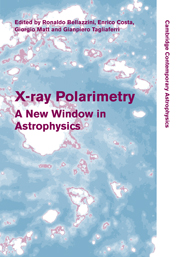Book contents
- Frontmatter
- Contents
- List of contributors
- Preface
- 1 X-ray polarimetry: historical remarks and other considerations
- Part I Polarimetry techniques
- Part II Polarized emission in X-ray sources
- 14 Probing strong gravity effects with X-ray polarimetry
- 15 X-ray polarization from black holes in the thermal state
- 16 Strong-gravity effects acting on polarization from orbiting spots
- 17 Polarization of thermal emission from accreting black holes
- 18 X-ray polarimetry and radio-quiet AGN
- 19 The soft X-ray polarization in obscured AGN
- 20 The polarization of complex X-ray sources
- 21 Polarization of Compton X-rays from jets in AGN
- 22 Polarization of X-ray lines from galaxy clusters and elliptical galaxies
- 23 Polarization characteristics of rotation-powered pulsars
- 24 Polarized X-rays from magnetized neutron stars
- 25 Polarization properties of X-ray millisecond pulsars
- 26 X-ray polarization signatures of neutron stars
- 27 Polarization from the oscillating magnetized accretion torus
- 28 X-ray polarization from accreting white dwarfs and associated systems
- 29 Polarization of pulsar wind nebulae
- 30 X-ray polarization of gamma-ray bursts
- 31 Central engine afterglow from GRBs and the polarization signature
- 32 GRB afterglow polarimetry past, present and future
- 33 Gamma-ray polarimetry with SPI
- 34 INTEGRAL/IBIS observations of the Crab nebula and GRB 041219A polarization
- 35 Fermi results on the origin of high-energy emission in pulsars
- 36 Diagnostics of the evolution of spiral galaxies in a cluster environment
- Part III Future missions
- Author index
- Subject index
32 - GRB afterglow polarimetry past, present and future
from Part II - Polarized emission in X-ray sources
Published online by Cambridge University Press: 06 July 2010
- Frontmatter
- Contents
- List of contributors
- Preface
- 1 X-ray polarimetry: historical remarks and other considerations
- Part I Polarimetry techniques
- Part II Polarized emission in X-ray sources
- 14 Probing strong gravity effects with X-ray polarimetry
- 15 X-ray polarization from black holes in the thermal state
- 16 Strong-gravity effects acting on polarization from orbiting spots
- 17 Polarization of thermal emission from accreting black holes
- 18 X-ray polarimetry and radio-quiet AGN
- 19 The soft X-ray polarization in obscured AGN
- 20 The polarization of complex X-ray sources
- 21 Polarization of Compton X-rays from jets in AGN
- 22 Polarization of X-ray lines from galaxy clusters and elliptical galaxies
- 23 Polarization characteristics of rotation-powered pulsars
- 24 Polarized X-rays from magnetized neutron stars
- 25 Polarization properties of X-ray millisecond pulsars
- 26 X-ray polarization signatures of neutron stars
- 27 Polarization from the oscillating magnetized accretion torus
- 28 X-ray polarization from accreting white dwarfs and associated systems
- 29 Polarization of pulsar wind nebulae
- 30 X-ray polarization of gamma-ray bursts
- 31 Central engine afterglow from GRBs and the polarization signature
- 32 GRB afterglow polarimetry past, present and future
- 33 Gamma-ray polarimetry with SPI
- 34 INTEGRAL/IBIS observations of the Crab nebula and GRB 041219A polarization
- 35 Fermi results on the origin of high-energy emission in pulsars
- 36 Diagnostics of the evolution of spiral galaxies in a cluster environment
- Part III Future missions
- Author index
- Subject index
Summary
Gamma-ray bursts and their afterglows are thought to be produced by an ultrarelativistic jet. One of the most important open questions is the out-flow composition: the energy may be carried out from the central source either as kinetic energy (of baryons and/or pairs), or in electromagnetic form (Poynting flux). While the total observable flux may be indistinguishable in both cases, its polarization properties are expected to differ markedly. The later time evolution of afterglow polarization is also a powerful diagnostic of the jet geometry. Again, with subtle and hardly detectable differences in the output flux, we have distinct polarization predictions.
Introduction
Polarimetry is a powerful diagnostic tool to study spatially unresolved sources at cosmological distances, such as gamma-ray burst (GRB) afterglows. Radiation mechanisms that produce similar spectra can be disentangled by means of their polarization signatures. Also, polarization provides unique insights into the geometry of the source, which remains hidden in the integrated light.
Historically, essentially all interpretative studies about GRB afterglow polarimetry have been based on the cosmological fireball model, which we will also use as a reference for our discussion. Afterglow polarization studies have indeed the advantage that different models are often almost indistinguishable in terms of radiation output in the optical, but produce markedly distinct predictions about polarization.
In this proceeding, we will briefly review in Section 32.2 what we have derived by optical afterglow polarimetric observations and discuss the most recent development in the field in Section 32.3.
- Type
- Chapter
- Information
- X-ray PolarimetryA New Window in Astrophysics, pp. 215 - 221Publisher: Cambridge University PressPrint publication year: 2010



